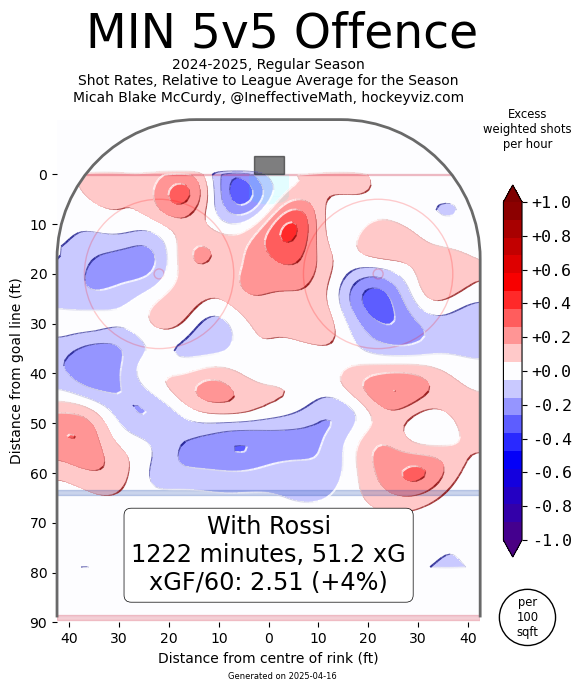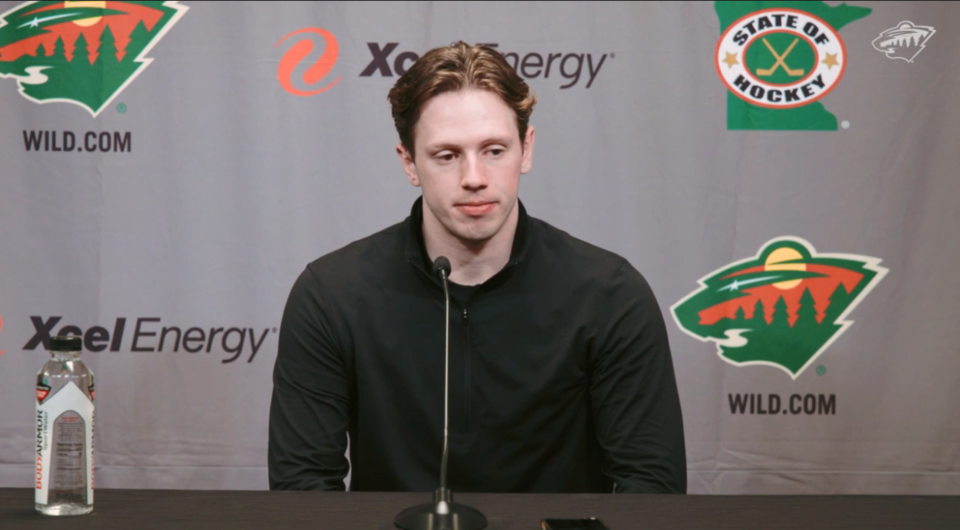The Vancouver Canucks need a second-line centre and have few avenues available to acquire one.
That was a focal point of the end-of-season press conference with Canucks general manager Patrik Allvin and president of hockey operations Jim Rutherford. Both emphasized the necessity of upgrading at centre after the departure of J.T. Miller.
“I think the biggest thing for us is to strengthen our centre ice,” said Rutherford, later adding, “I think it would be tough to do in free agency, to get a top-two centre, because based on the list that we’ve looked at, we’re gonna have to do better than that. So, it’s probably a trade.”
Upgrading via free agency will be tough for multiple reasons. The competition for top free agents will be fierce and the Canucks don’t have a particularly compelling case for Vancouver, given they have a new, untested head coach and they’re coming off an ugly season marred by locker room issues.
The trouble with a trade is that the Canucks have limited assets to work with. Their prospect pool isn’t particularly deep, and they don’t have any extra picks in upcoming drafts. Trading for a top-six centre likely means moving the 15th-overall pick and/or a top prospect that, in an ideal world, they would rather keep.
“It’ll be expensive, but it’ll also be very expensive not to get one,” said Rutherford about acquiring a top-six centre. “We’re going to be open to do whatever it takes, and probably on the trade market, to get that player. It depends what level the player is at, as to what we’re willing to give up.”
What the Canucks are looking for is a bit of a unicorn: a player capable of being a second-line centre that another team doesn’t want to keep. Preferably, that player would be on the younger side, just about to enter his prime.
There simply aren’t many players like that out there.
But Marco Rossi might be one of them.
Rossi is young, talented, and available
The 23-year-old Rossi is coming off back-to-back 20+ goal seasons for the Minnesota Wild and had 60 points in 82 games this past season, which tied him for 74th among NHL forwards. That’s low-end first-line production, let alone second-line.
Given the Canucks’ struggles to produce at even-strength this past season, it also seems worth noting that 17 of his 24 goals and 44 of his 60 points came at even-strength.
In other words, Rossi was a legitimate top-six centre for the Wild this past season, frequently filling in as a first-line centre as the Wild dealt with injuries.
At least, he was a top-six centre until the playoffs, when the Wild unceremoniously demoted Rossi to the fourth line. Rossi’s ice time was slashed from 18:15 per game in the regular season to just 11:08 per game in the playoffs.
The Wild downplayed the demotion, and Rossi took it on the chin with a “team-first” quote, but in his year-end media availability, he said he “was very disappointed” with his usage in the playoffs. And now there’s growing speculation that the Wild won’t meet his contract demands and that the pending restricted free agent is likely on his way out of Minnesota, whether via trade or an offer sheet.
In fact, there are reports that the Wild have been shopping Rossi for nearly a full year.
So, Rossi is that extremely rare thing: a young, proven top-six centre, who his team is actually willing to trade. But why?
Has Rossi priced himself out of Minnesota?
The primary issue appears to be that the Wild don’t want to pay Rossi like a top-six centre. They reportedly offered him a five-year deal worth $5 million per year, an offer that would eat up a couple of years where he could become an unrestricted free agent at a pittance of what he could fetch in free agency.
Unsurprisingly, Rossi turned down that reported offer and is looking for “north of $7 million,” according to Michael Russo of The Athletic.
That fits with contract projections. AFP Analytics has two projections for Rossi: a two-year bridge contract and a seven-year long-term deal that would eat up several years of unrestricted free agency. The short-term projection carries a cap hit of around $4.5 million, while the long-term projection has a cap hit of around $7.4 million.
The Wild don’t want to pay that kind of money for Rossi, seemingly not sold on his bona fides as a top-six centre long-term. Their decision-making might also be driven by a looming cap crunch, with superstar forward Kirill Kaprizov and number-one goaltender Filip Gustavsson in need of new contracts that will kick in after next season.
All of this makes Rossi a prime candidate for an offer sheet, though it would be a pricey one, as the type of offer sheet the Wild wouldn’t match would likely be in the $7.5 million range, which would cost the team that signed him first, second, and third-round picks.
The Canucks don’t have their own third-round pick, so can’t sign Rossi to an offer sheet without reacquiring it. Let’s say, for the moment, that an offer sheet is off the table.
Here’s the challenge the Canucks face in trading for Rossi: any trade offer they make would have to be more enticing than the first, second, and third-round picks the Wild would receive as the result of an offer sheet.
That means a trade offer for Rossi starts, but does not end, with their first-round pick. The Wild are looking to build a Cup-contending team, so will want players that can contribute immediately, which likely means one of the Canucks’ top prospects, of which they have few.
That leads to the key question: is Rossi worth the price it would take to acquire him?
Would Rossi be a fit for the Canucks?
Let’s be clear: Rossi didn’t just produce like a top-six centre this past season; his underlying numbers also painted the picture of a legitimate top-six centre.
Rossi’s 50.1% corsi was sixth among Wild forwards; his 53.3% expected goals was fourth. The Wild outscored their opponents 56-to-43 when he was on the ice at 5-on-5 — only Joel Eriksson Ek and Kirill Kaprizov had a better ratio on the Wild.
Rossi's 5-on-5 heat map in the offensive zone from HockeyViz illustrates where the shots came from for the Wild when Rossi was on the ice: all around the slot and in front of the net.

In other words, Rossi tilted the ice in the right direction at 5-on-5, and was able to create scoring chances at even-strength, something the Canucks struggled to do this past season. In addition, Rossi didn't give up much defensively in the process, holding his own as a two-way forward.
Rossi also led the Wild with seven power play goals, generally playing on the left half-boards, while also rotating into the slot or to the net-front.
Some bounces certainly went Rossi’s way this season. His 17.6% shooting percentage was definitely well above league-average and a step up from his 12.6% shooting percentage last season. In addition, the Wild’s 9.9% shooting percentage when Rossi was on the ice at 5-on-5 is above average, though not by enough to be too concerned about regression.
Even with that in mind, there’s little reason to see Rossi as a flash-in-the-pan. He’s a scrappy, hard-working player, who gives every indication that he’s only going to get better.
But is Rossi the right fit for what the Canucks want in a second-line centre?
The first issue is that Rossi is small. He’s 5’9”, though he’s stocky at 182 lbs. The Canucks’ top centre, Elias Pettersson, is tall but slight, while Filip Chytil has decent size but doesn’t play a particularly physical game. In other words, Rossi isn’t the type of centre the Canucks are likely looking for to play on the second line in between Pettersson and Chytil.
The Canucks’ ideal top-six centre would be a bigger, more physical match-up centre, preferably one who can also win faceoffs and play on the penalty kill. That’s not Rossi, who is mediocre at faceoffs, winning just 46.8% of his draws last season, and he doesn’t kill penalties.
That’s not to say Rossi can’t match up against tough competition. He had the second-highest ice time against elite competition among Wild forwards, according to Puck IQ, and fared well in those minutes, with a 54.3% dangerous fenwick percentage (DFF%), which is a measure of shot quality. If that’s not compelling, the Wild outscored their opponents 19-to-8 when Rossi was on the ice against elite competition at 5-on-5.
So perhaps it's less a question of whether the Canucks should acquire Rossi but whether or not they will attempt to do so.
Pettersson, Rossi, and Chytil down the middle could be effective, with both Pettersson and Rossi both able to match up against top lines despite not being prototypical match-up centres. But it’s hard to imagine this Canucks’ management group being comfortable with that group.
Combine that with the cost of acquisition and it seems unlikely that the Canucks will go after Rossi hard enough to beat out the other offers the Wild are likely to receive or the compensation from a significant offer sheet.




